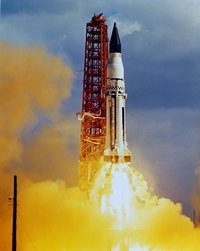SA-5 (Apollo)
|
|
SA-5 was the first launch of the Block II Saturn I rocket and was part of the Apollo Program.
| Mission Insignia | |
|---|---|
| Mission Statistics | |
| Mission Name: | Saturn-Apollo 5 |
| Call Sign: | SA-5 |
| Launch: | January 29, 1964 16:25:01 UTC Cape Canaveral Complex 37B |
| Reentry: | April 30, 1966 --:--:-- UTC |
| Duration: | 791 days |
| Number of Orbits: | ~12,000 |
| Apogee: | 472 mi (760 km) |
| Perigee: | 164 mi (264 km) |
| Period: | 94.8 min |
| Inclination | 31.5 deg |
| Distance Traveled: | 322,779,790 mi (519,463,719 km) |
| Apogee Mass: | 38,700 lb (17,550 kg) |
| SA-5 | |
Upgrades and objectives
The major changes that occurred on SA-5 were that for the first time the Saturn I would fly with two stage - the S-I first stage and the S-IV second stage. The second stage featured six engines burning liquid hydrogen. Although this design was meant to be tested several years earlier in the Centaur rocket design, in the end the first Centaur launch was only two months before SA-5. This rocket stage was delivered to the Cape by a modified B-377 aircraft, nicknamed the Pregnant Guppy.
Other major design changes included the enlargement of the fuel tanks on the first stage. For the first time the rocket would carry its planned 750,000 lb (340,000 kg) of propellant and would use eight upgraded engines producing a thrust each of 188,000 lbf (836 kN). The first stage also featured for the first time eight fins for added stability during flight. But as with the earlier flight the rocket would still only carry a Jupiter-C nosecone instead of a boilerplate Apollo spacecraft.
Also the guidance and control computer on the rocket was positioned above the second stage. This was where it would be found on the Saturn V flights that would take astronauts to the moon. The Instrument Unit controlled the ascent of the rocket through the atmosphere, automatically compensating for any winds or loss of thrust during the ascent.
For the first time in the Apollo program, this flight would be an orbital mission. This was possible because of the upgraded first stage and the addition of the second stage. It would enter into a highly ellipitical orbit and reenter a couple of days later as its orbit decayed.
Flight
The first scheduled launch attempt was for 27 January, with all going well until 93% of the liquid oxygen (LOX) had been loaded into the first stage. At this time, the ground crews switched it from a fast fill to a replenish system. However the LOX in the tanks began to fall meaning that it was not being replenished. The cause was found to a flange (plate without an opening) in the line. This could not be removed easily and the launch had to be postponed for two days.
The second launch attempt had no such problems and lifted off into overcast skies just before noon local time. The rocket sent back 1,183 separate measurements to the ground during the flight while at the same time it was tracked by six telescopes. For the first 1000 metres the rocket was filmed by 13 cameras that looked for any pitch, yaw, and roll movements.
The separation of the two rocket stages was filmed by eight cameras that themselves separated from the rocket to be recovered 800 km downrange in the Atlantic Ocean. The whole stage separation system worked perfectly with the retrorockets firing on the first stage to decelerate it and ullage rockets on the S-IV firing the settle its fuel to aft of the stage.
After an eight minute burn, the second stage entered into a 262 km by 785 km orbit. At 16,965 kg it was the largest satellite ever to go into orbit at that time. However the achievement of Earth orbit it turned out was not even an objective of the mission but just an added bonus. It did show to the American public that the United States had bridged the missile gap.
External links
- The Apollo Spacecraft: A Chronology (http://www.hq.nasa.gov/office/pao/History/SP-4009/cover.htm)
- http://nssdc.gsfc.nasa.gov/database/MasterCatalog?sc=1964-005A
- Moonport: A History of Apollo Launch Facilities and Operations (http://www.hq.nasa.gov/office/pao/History/SP-4204/cover.html)
- http://science.ksc.nasa.gov/history/apollo/sa-5/sa-5.html
- Stages to Saturn (http://history.nasa.gov/SP-4206/sp4206.htm)


